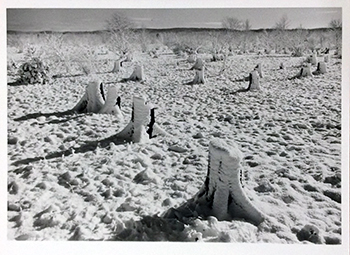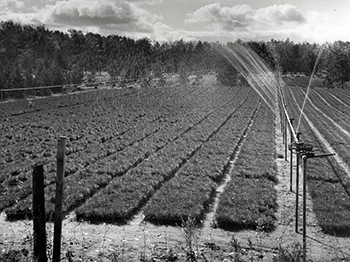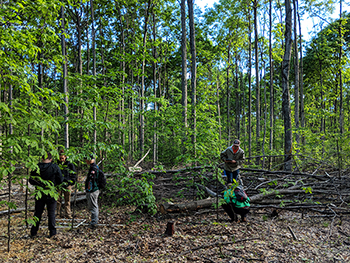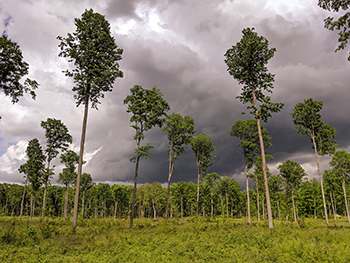Michigan's forest stewardship heritage
Past, present and future, stewardship remains vital to state forest resources
By KATHLEEN LAVEY
Michigan Department of Natural Resources
At the turn of the 20th century, some of Michigan’s greatest conservation minds focused on a very important issue: turning vast, logged-over stump fields back into forests.
It wasn’t an easy sell at first.
Hillary Pine, a historian based in Crawford County at Hartwick Pines State Park – which features an old-growth white pine forest and a logging museum among its 9,762 acres – said the first state forests were founded in 1902.
The Higgins Lake Nursery in Roscommon County was started a year later.
“At that time, there was pushback from locals,” Pine said. “They said, ‘We’re growing crops, what are trees going to do for us? That’s useless.’”

Despite the opposition, conservationists carried on with their admittedly lofty replanting goal. It came with its own set of challenges.
“They wanted to regrow forests on a monumental scale,” Pine said. “How do you plant the seeds? How deep do you plant them? How do you protect them from birds and pests? It was a big experiment in how to do it properly and successfully.”
There were a few misses. An attempt to grow eucalyptus trees didn’t work out.
But there were many successes, and eventually, much of Michigan was successfully planted in jack pine, red pine and other species of trees.
Current conditions
Nearly 120 years later, foresters are still carefully studying Michigan’s forests to determine the best ways to help them thrive well into the 22nd century and beyond.
Today, 20 million acres, or half of Michigan’s land mass, is covered with forests, ranging from young aspens to ancient hemlocks. There are nearly 4 million acres of state forest in Michigan’s northern Lower and Upper peninsulas. There are also 3 million acres of federal forest land in the state.
That’s all because forests are managed to provide for a huge range of activities. That includes all types of recreation, wildlife habitat for everything from tiny birds and butterflies to enormous elk, and timber harvests to make products people use every day, from lumber to toilet paper.
“Vigorous and healthy forests would not be here with a hands-off approach,” said Jason Hartman, DNR silviculturist. Silviculture is the science of caring for and cultivating trees.
“This new era with climate change is going to require a tremendous amount of stewardship,” Hartman said. “Everyone seems to want to plant more trees, which is great. We just need to be strategic.”
|

Some important Michigan trees such as aspen and jack pine are at the southern end of their current geographic range and need cool temperatures to thrive. But DNR data shows that mean temperatures in the state rose between 1969 and 2020.
That means Michigan’s forests may lose a few iconic tree species in the next 100 years, but at the same time may gain a few different tree species as southern trees expand their range to the north.
Coping with a changing climate
One of the stewardship tasks the DNR is considering now is a process known as “assisted tree migration.”
“We are basically just selecting some species from farther south to plant as tests across different latitudes in Michigan,” Hartman said. “For instance, we are planning to plant some hickory trees in Lansing and Gaylord and Shingleton. We want to see which species perform best if assisted migration were to become operational.”
Hickory currently thrives in southern Michigan but becomes rare as you head north. It’s an important prospect because its hard-shelled nuts provide food for wildlife through the winter.
Other hardwood species under consideration for assisted migration include yellow poplar, walnut and perhaps some of the southern species of oak or blue ash, which resists the invasive and destructive emerald ash borer.
DNR foresters also are looking at species that could possibly replace red pine and jack pine in the distant future, and additional experiments are likely to include growing short-leaf pine and pitch pine in Michigan.
Short-leaf pine grows in southeastern Ohio, the Ozarks and much of the south. Pitch pine currently grows on the east coast and in portions of the south.
|

Besides looking at trees that thrive in warmer southern temperatures, the experiments also will include working to improve existing forests.
“It’s also about selecting genetic diversity from the species we currently have that would be the best performers,” Hartman said.
The DNR works closely with Michigan State University on tree genetics, to improve the quality of seedlings grown for state forests.
Hartman said any species that will be test-planted will be carefully studied to make sure they fit in with the current forest – so that eucalyptus experiment of the early 1900s is unlikely to have a modern repeat.
“We’re not going to move any species that have the potential to be invasive,” Hartman said.
What is natural regeneration?
During the 1930s, the young men of the Civilian Conservation Corps planted 484 million trees in Michigan, twice as many as any other state.
“We may be entering a modern day CCC era due to the amount of reforestation being promoted,” Hartman said.
Sending an army of young men to turn fields into forests may not be feasible today, but there are other ways to get more, and healthier, trees into the landscape.
For example, the DNR and MSU researchers have been working on a large-scale project to improve the way that Michigan’s valuable hardwood trees, such as sugar maple, regenerate naturally.
|

They’ve set up cameras in the woods to watch deer as they browse for tender seedlings to eat and tested different methods of harvesting trees.
They’ve also studied different ways of disturbing the surface of the ground to allow seeds to set better and treating unwanted species in the understory to allow desirable trees to grow.
Working against invasive species
The DNR has also worked with various other researchers to blunt the devastating effects of disease or invasive species.
One historic success is lowering the impacts of Lymantria dispar dispar, formerly known as gypsy moth. Although the size of the population cycles from year to year, its impacts on forest health have been greatly reduced by naturalizing the population across the state.
Today, predators, parasitoids, a fungus called Entomophaga maimaiga and the nuclear polyhedrosis virus play key roles in limiting moth outbreaks and keeping populations in a regular cycle.
Another effort under way seeks to restore the state’s ash trees, which have been devastated over the past 20 years by the bright-green emerald ash borer.
An ash orchard of insect-resistant trees has been established. Restoration work is still a few years away, but the effort has the potential to get resilient ash trees back into Michigan’s forests.
The DNR also is working with federal and local authorities to stop the spread of the hemlock woolly adelgid on Michigan’s west coast. The adelgid is another destructive insect pest.
These efforts include identifying infested trees and treating them to help prevent hemlock mortality, as well as educating people to be aware of the invasive pest and help keep it from spreading.
|

Michigan’s state forests have come a long way in 120 years, helped along by human ingenuity. That will be even more important in the years to come.
“Stewardship is going to increase, it’s not going to decrease,” Hartman said. “It’s getting our hands dirty in nature. It’s finding ways to make good effects, planting trees of the right species in the right place, cutting trees at the right time, things like that.”
For more information on forest stewardship in Michigan visit Michigan.gov/ForestStewardship.
Check out previous Showcasing the DNR stories in our archive at Michigan.gov/DNRStories. To subscribe to upcoming Showcasing articles, sign up for free email delivery at Michigan.gov/DNR.
|
Check out previous Showcasing the DNR stories in our archive at Michigan.gov/DNRStories. To subscribe to upcoming Showcasing articles, sign up for free email delivery at Michigan.gov/DNR.
Note to editors: Contact: John Pepin, Showcasing the DNR series editor, 906-226-1352. Accompanying photos and a text-only version of this story are available below for download. Caption information follows. Credit Michigan Department of Natural Resources, unless otherwise noted.
Text-only Showcasing Story - Forest Regeneration
CCC: Members of the Civilian Conservation Corps plant rows of trees in the Huron Manistee Forest during the 1930s. The CCC was responsible for planting 484 million trees in state and federal forests in Michigan.
Cutover: A winter scene of a cutover forest in Crawford County in the early 1900s, from Michigan’s archives.
Regeneration: Planting nursery-grown seedlings is one way to reforest the land; another is known as natural regeneration. Michigan Department of Natural Resources and Michigan State University researchers are looking at various ways to allow forests to regrow naturally, including leaving some wood on the ground to protect tasty seedlings from hungry deer.
Seed tree: One method of natural regeneration is to leave some mature trees in place to re-seed a cutover area.
Seedlings: The DNR researches ways to improve Michigan’s tree stock at the Tree Improvement Center in Brighton, where seedlings for the state forest also are grown.
Sprinklers: Sprinklers water seedlings at the Higgins Lake Nursery, where trees were grown to reforest the state after the lumber era.
|